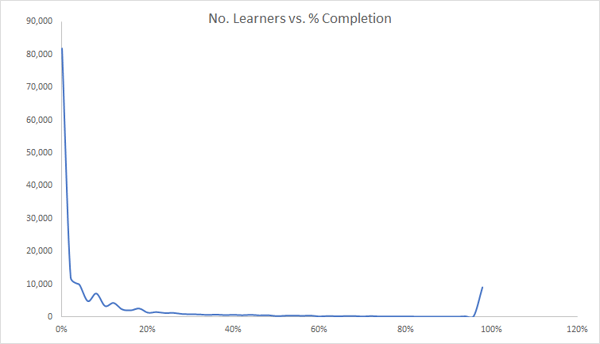Answer: People buy online courses but they rarely complete them.
Our business has two sides. We provide intelligent learning recommendations to businesses through Filtered. And we offer online courses to consumers (B2C) with our Excel with Business brand.
Competing in these two arenas is unusual and this gives us an interesting perspective on learning; we frequently deal with the same challenges from our B2C customers that L&D departments face:
How do I increase engagement?
You’d like your staff to learn more, you give them great tools and access to online courses. But they use the training infrequently and rarely complete it. If that sounds familiar, don’t be too hard on yourself. Based on users that bought online courses using their own money, here’s what we found:
- 5% of users actually completed a full course
- 9% of users completed over 50% of a course
- 1.6 million modules were completed (approximately 10 modules per user)
 Y axis = No. Users, X axis = % modules completed
Y axis = No. Users, X axis = % modules completed
- These are people that are (in most cases) buying a course(s) with their own money.
- They are people that are motivated to learn and better themselves (why go and buy a course if you’re not?)
- 1.6 million modules is a lot of learning. People are engaging, starting courses, often multiple courses, but only 9% of them complete more than half a course.
On the one hand, there is learning taking place, on the other, there isn’t the follow through to completion.
Why is that?
Maybe the quality of the courses is an issue? With a couple more data points this doesn’t look like this is the cause. During the period we looked at our customers spent over £3 million on learning with us, many of them repeat customers, and we’ve maintained a TrustPilot score 9/10 or higher.
We recently telephone interviewed over 100 of our top buyers. We call this group of users ‘members’ as they’ve paid to have access to all our courses. We offer monthly or annual subscriptions for this or occasionally, a pay once price that lets you keep the courses (Lifetime Membership).
We asked our Lifetime Members the main reason they went for that option. They pretty much all said, it was about giving them unlimited time to complete their courses. Many of them were paying monthly or annually but were fine paying a significant amount more to end that time pressure.
Time
Time seems to be the causal factor here. Without going too ‘big picture’, most of the UK and US workforce fail to prioritise non-essential items, even if they know they should (Laura Vanderkam explains this concept well). At work we find ourselves under ever increasing pressure to perform and achieve great results. Why? The world is moving at a faster pace, enabled by technology. Capitalism ensures only the survival of the best.
Learning is a vitamin not a pain killer. Its benefits are not usually immediate. So it ends up losing out against more immediate concerns.
I believe that this extra pressure on time has had a big impact on learning in the workplace and at home. There is still a desire to learn, people are buying learning - more so than ever. But the way people learn has changed. They dip into learning resources, they are looking for immediate value and quick wins. The majority of learning providers are still selling a course format, it’s what people are used to so that’s what they buy. But maybe it’s not what they really need?
Continuous Learning
So if the way we learn has changed, what has it changed to? In my opinion: ‘continuous learning’.
Information is more available now than it’s ever been. Thanks to the internet (and Google) you are only ever seconds away from the answer to most questions. There is so much amazing content available for free, from mainstream publishers like HBR, TED or the BBC to niche blogs and newsletters. Every time someone reads an article, watches a video or listens to a podcast, that’s a learning intervention. Yes, they aren’t completing a course, but they are learning.
Quality & Curation
The problem with having so much content is that it can be difficult to sort the wheat from the chaff. There are some great recommendation tools out there, Anders Pink and Pocket are two that spring to mind. Our own, magpie, utilises Artificial Intelligence (AI) to recommend learning assets (videos, articles, courses, podcasts) to each person using it based on their role, seniority and content they like. magpie puts the company in charge of the content that your employees see, be that courses that you own already or free content from the internet. We use xAPI to track everything so all learning is captured.
Is this the end for courses? Definitely not. People still like the structure a course brings and they still buy them. But we need to be conscious of how we build those courses for our time-pressed consumers and we need to think carefully about what else constitutes a learning intervention and how we measure that.
So what did we really learn from 1 million users?
Answer: The way people learn has improved. Learners have adapted to a world of multiple providers, near-limitless choice and self-directed, continuous learning responsibility. What counts as success for your learning programmes must correspondingly adapt and improve, certainly beyond completion rates.

